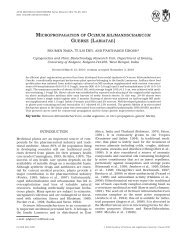ACTA BIOLOGICA CRACOVIENSIA
ACTA BIOLOGICA CRACOVIENSIA
ACTA BIOLOGICA CRACOVIENSIA
Create successful ePaper yourself
Turn your PDF publications into a flip-book with our unique Google optimized e-Paper software.
16 TH INTERNATIONAL SYMPOSIUM ON CAROTENOIDS<br />
2.5.<br />
Antioxidant properties of carotenoids in model<br />
pigment-protein systems<br />
Aleksandra Sulikowska1 , Aleksandra Orzechowska1 ,<br />
Leszek Fiedor2 , Kvetoslava Burda1 , Joanna Fiedor1 1 Department of Medical Physics and Biophysics, Faculty of Physics<br />
and Applied Computer Science, AGH-University of Science and<br />
Technology, 30-059 Krakow, Mickiewicza 30, Poland,<br />
aleksandra.sulikowska@gmail.com,<br />
orzechowska@novell.ftj.agh.edu.pl, burda@novell.ftj.agh.edu.pl,<br />
fiedor@novell.ftj.agh.edu.pl<br />
2 Department of Plant Physiology and Biochemistry, Faculty of<br />
Biochemistry, Biophysics and Biotechnology, Jagiellonian<br />
University, 30-387 Krakow, Gronostajowa 7, Poland,<br />
leszek.fiedor@uj.edu.pl<br />
Carotenoids are structurally and functionally a very diverse group<br />
of isoprenoid pigments. They occur commonly in all photosynthetic<br />
organisms carrying out diverse functions. Apart from light<br />
harvesting and structural function (photo)protection is considered<br />
as one of their most important role, however still not fully<br />
understood. Carotenoids are well known physical quenchers of<br />
chlorophyll excited states and reactive oxygen species. They also<br />
act as efficient chemical quenchers of reactive species undergoing<br />
irreversible modifications (Fiedor et al., 2005).<br />
In the present study we investigated the protective role of<br />
carotenoids toward chemically oxidised (bacterio)chlorophylls in<br />
model pigment-protein complexes. In this approach a series of<br />
model LH1 complexes was prepared with carotenoids that significantly<br />
differed in structure (i.e. length of their C=C bonds, presence<br />
of additional side groups), following a recently developed<br />
method (Fiedor et al., 2004). For oxidation reactions various concentrations<br />
of either potassium ferricyanide or hydrogen peroxide<br />
was used. The progress of oxidation reaction of model LH1 complexes<br />
was monitored by following the changes in their UV-VIS<br />
absorption, fluorescence and thermoluminescence spectra.<br />
Oxidation of model pigment-protein complexes with either potassium<br />
ferricyanide or hydrogen peroxide leads to irreversible<br />
changes in their absorption spectra indicating progressive<br />
decomposition of the pigments. The changes in absorption spectra<br />
are paralleled with the decrease of emission intensity in fluorescence<br />
spectra and a temperature shift observed in thermoluminescence<br />
spectra. Our results indicate that carotenoid presence<br />
do affect the stability of a complex exposed to chemical oxidation.<br />
The most stable are complexes reconstituted with longchain<br />
carotenoids.<br />
REFERENCES<br />
FIEDOR J, FIEDOR L, HEASSNER R, SCHEER H. 2005. Cyclic endoperoxides<br />
of β-carotene, potential pro-oxidants, as products of chemical<br />
quenching of single oxygen. Biochim. Biophys. Acta 1709: 1-4.<br />
FIEDOR L, AKAHANE, J, KOYAMA Y. Carotenoid-induced cooperative formation<br />
of bacterial photosynthetic LH1 complex. Biochemistry<br />
43: 16487-16496.<br />
2.6.<br />
The influence of carotenoid population on<br />
the structure and fluorescence emission<br />
properties of the LH2 light-complex from<br />
Rhodopseudomonas palustris<br />
Andrew Gall 1 , Trjaart Krüger 2 , Cristian Ilioaia 2 ,<br />
Rienk van Grondelle 2 , Bruno Robert 1<br />
SESSION 2<br />
1 CEA, Institute of Biology and Technology of Saclay, URA 2096<br />
CNRS, 91191 Gif sur Yvette, France, andrew.gall@cea.fr,<br />
bruno.robert@cea.fr<br />
2 Department of Physics and Astronomy, Faculty of Sciences, Vrije<br />
Universiteit, Amsterdam, De Boelelaan 1081 HV Amsterdam,<br />
The Netherlands, t.p.j.kruger@vu.nl, c.ilioaia@vu.nl,<br />
r.van.grondelle@vu.nl<br />
It is known that varying the growth conditions of purple photosynthetic<br />
bacteria different carotenoids may be incorporated into<br />
the light-harvesting (LH) complexes. This can be achieved by<br />
either culturing the cells under different light regimes, or in the in<br />
the presence of diphenylamine (DPA) which inhibits the activity of<br />
phytoene desaturase. We will present our recent work on the<br />
influence of carotenoid type on the structure and fluorescence<br />
properties of isolated LH2 molecules.<br />
2.7.<br />
Excitation energy dependence of intramolecular<br />
charge transfer dynamics of fucoxanthin<br />
Daisuke Kosumi1,2 , Ritsuko Fujii1,2 , Mitsuru Sugisaki1,2,3 ,<br />
Masahiko Iha 4 , Harry A. Frank5 , Hideki Hashimoto1,2,3 1The Osaka City University Advanced Research Institute for<br />
Natural Science and Technology (OCARINA), 3-3-138 Sugimoto,<br />
Sumiyoshi-ku, Osaka 558-8585, Japan<br />
2CREST/JST, 4-1-8 Hon-chou, Kawaguchi, Saitama 332-0012,<br />
Japan<br />
3Department of Physics, Graduate School of Science, Osaka City<br />
University, 3-3-138 Sugimoto, Sumiyoshi-ku, Osaka 558-8585,<br />
Japan<br />
4South Product Co. Ltd., 12-75 Suzaki, Uruma-shi, Okinawa<br />
904-2234, Japan<br />
5Department of Chemistry, University of Connecticut, Storrs,<br />
CT 06269-3060, USA<br />
Carotenoids containing a carbonyl group in conjugation with their<br />
polyene backbone are naturally-occurring pigments in marine<br />
organisms and are essential to the photosynthetic light-harvesting<br />
function in aquatic algae. These carotenoids exhibit spectral characteristics<br />
attributed to an intramolecular charge transfer (ICT)<br />
state that arise in polar solvents due to the presence of the carbonyl<br />
group. In this study, we report the spectroscopic properties<br />
of the carbonyl containing carotenoid fucoxanthin in polar<br />
(methanol) and nonpolar (cyclohexane) solvents investigated by<br />
steady-state absorption and femtosecond pump-probe measurements.<br />
Transient absorption associated with the optically forbidden<br />
S 1 (2 1 Ag – ) state and/or the ICT state were observed following<br />
one-photon excitation to the optically allowed S 2 (1 1 B u + ) state in<br />
methanol. The transient absorption measurements carried out in<br />
methanol showed that the ratio of the ICT-to-S 1 state formation<br />
increased with decreasing excitation energy. We also showed that<br />
the ICT character was clearly visible in the steady-state absorption<br />
in methanol based on a Franck-Condon analysis. The results<br />
suggest that two spectroscopic forms of fucoxanthin, blue and<br />
red, exist in the polar environment.<br />
38 <strong>ACTA</strong> <strong>BIOLOGICA</strong> <strong>CRACOVIENSIA</strong> Series Botanica












